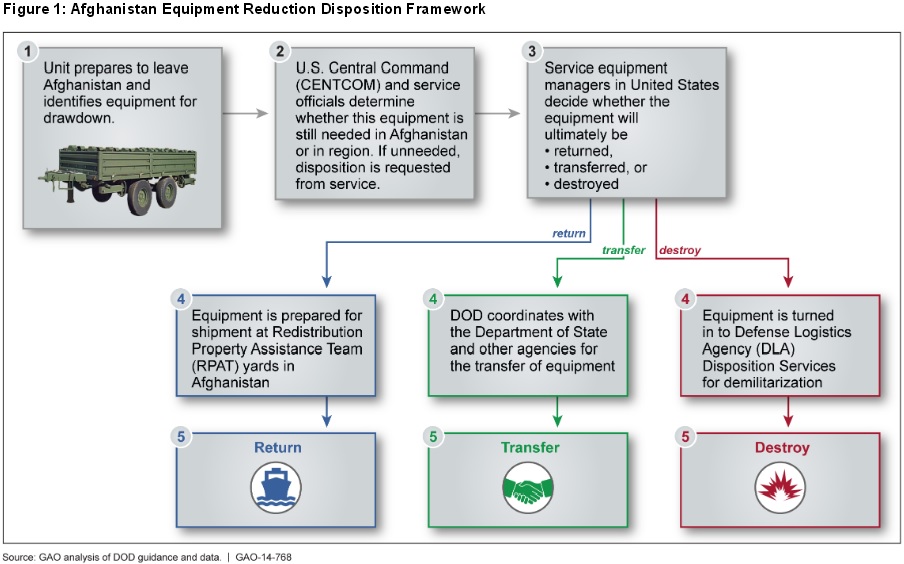Afghanistan Drawdown
After almost 14 years in Afghanistan, the U.S. military has sent tons of equipment to the region. With combat operations in Afghanistan diminishing, the Department of Defense anticipates that the drawdown will be viewed as one of the most complex logistical operations in U.S. military history. Read on for some of the challenges—and expenses—of getting everything home.
Rolling out
DOD has two types of equipment: “non-rolling items” that must be shipped in containers and “rolling stock” that (as its name suggests) can drive away.
Despite being on wheels, vehicles are the most challenging equipment to move out of Afghanistan, according to DOD officials. In that landlocked country, it takes weeks to drive to the nearest seaport, and there’s no staging area where equipment can be stored to await processing and transportation.
For that reason, DOD officials track vehicle movement to monitor the progress of the U.S. drawdown.
Dealing with what’s left
DOD has 3 basic options for disposing of equipment in Afghanistan. Equipment can
- return to DOD inventories outside of Afghanistan,
- transfer to another U.S. government agency or the government of another country, or
- be destroyed in Afghanistan.
 (Excerpted from GAO-14-768)
(Excerpted from GAO-14-768)
Estimating costs
Getting vehicles and other rolling stock out of Afghanistan can cost from under $6,000 to over $100,000, depending on the route. For example, transportation by ground and sea through Russia or Pakistan is substantially cheaper than air and sea through Jordan or Azerbaijan.
Given these costs, in some cases it may be cheaper to destroy older or damaged equipment in Afghanistan. But the Army and Marine Corps have had ineffective internal controls to make sure this happens, so we recommended that they include transportation and other relevant costs in their disposition decision-making.
Yet, in other areas, DOD has taken steps to manage Afghanistan drawdown costs. For example, amended guidance allows DOD to amass equipment at U.S. ports, which can allow equipment to be shipped by rail, a potentially cheaper option than trucking.
Check out the full report for all the details, recommendations, and DOD’s response.
Comments on GAO’s WatchBlog? Contact blog@gao.gov.
GAO Contacts

GAO's mission is to provide Congress with fact-based, nonpartisan information that can help improve federal government performance and ensure accountability for the benefit of the American people. GAO launched its WatchBlog in January, 2014, as part of its continuing effort to reach its audiences—Congress and the American people—where they are currently looking for information.
The blog format allows GAO to provide a little more context about its work than it can offer on its other social media platforms. Posts will tie GAO work to current events and the news; show how GAO’s work is affecting agencies or legislation; highlight reports, testimonies, and issue areas where GAO does work; and provide information about GAO itself, among other things.
Please send any feedback on GAO's WatchBlog to blog@gao.gov.

